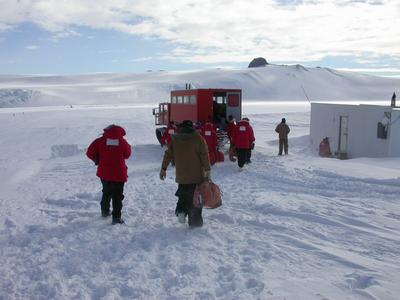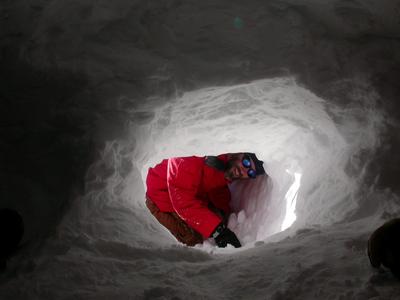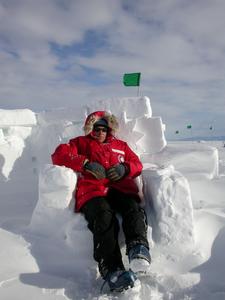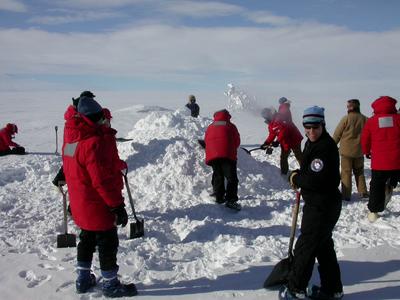
|
|
5 November, 2002
Can you really sleep in a snow cave? And other cool snow school stories.
Making friends with the snow is an important part of the adjustment to living and working in Antarctica. The US Antarctic program recognizes that most people who journey to the frozen continent are not as comfortable in the snow as they need to be to survive in an emergency situation should one happen while they are in the field. Therefore, anyone who will be going to the field is required to spend 48 hours in "happy camper" or snow school.
Our chance to go to snow school and survive took place over these past two days. We were told to report to the Science Support Center at 0900 hours dressed in all of our ECW (warmest) clothing and to bring with us a water bottle and a change of clothes. All the remainder of our necessary equipment and food would be supplied. Of the ITASE team only Jim Laatsch and I were required to go to school since the rest of the team has prior experience in the field. So teammate, Dan Dixon, waved us a smiling goodbye this morning as we trundled across the McMurdo campus in all of our heaviest gear.
How does one make friends with such a foreign environment? Our instructors from the field safety training program were masterful at easing us in to the snow with activities such as building a block wall and setting up tents. By staying involved in the activity of the moment, we kept our minds off the nagging questions hovering in our heads questions like; "Can you really sleep in a snow cave?" " How will I stay warm out here all night?" " Will there be enough food and warm drinks for all of us with just a few camp stoves and pots?" The afternoon moved by rapidly as we built a variety of snow shelters and learned important skills, such as using the HF or high frequency radio.
For snow shelters we began with a quinsy hut. The quinsy hut is a low-tech version of an igloo. To make one we piled our eighteen duffel bags in one big heap and on command from the instructors, Brian and Tom, covered them with a couple of feet of snow. This began to break down our inhibitions about working as a group and getting covered in snow. Soon the snow was flying from our shovels, and our bags were completely invisible. We left this mound to sinter, or freeze solid, in the sunlight and went off to get even more up close with the snow. Soon the wind began to pick up and we realized that we needed a wind screen to protect our tents from the intense Antarctic winds, so our next challenge was to build a snow wall. To do this, our instructors emerged with snow saws and shovels. A quick demonstration and we all jumped in to help with the sawing, digging and carrying of the blocks of snow to build several protective walls around our tents. People could be seen crawling, digging, lifting, carrying and shaping the snow. As each hour passed, the sun moved lower in the sky, the clouds and wind increased and the temperatures dropped. Night was approaching, it was getting harder to ignore the in our minds asking, "can you really sleep in a snow cave?" Our attention returned to the quinsy hut, it was time to dig a small door and to remove the pile of duffel bags from its center. Jim volunteered to be the first one into the tube shaped doorway barely big enough for his shoulders. He dug his way in and began handing out the bags. In about half an hour Jim reemerged covered from head to toe in snow, grinning from ear to ear. Mission accomplished, we had a snow cave large enough to sleep several members of our group. Around 7pm, our instructors satisfied that they had shown us the basics of snow survival quietly disappeared back to the warmth of their hut, leaving the eighteen snow neophytes to survive the night outdoors.
The pace quickened directly with the temperature drop, people teamed up to build more shelters, heat wter and secure the camp for the night. I choose to be brave and try out the snow cave with Jim and one other snow camper. The three of us squeezed our sleeping gear into place, trying to avoid knocking the snow from the roof of the cave into our bags as we took off our boots and outerwear for the night. Soon we were all in our sleeping bags completely enclosed and protected from the environment by snow. What had earlier been our "enemy" was now our blanket. We looked forward to our first night in the snow cave. It had been a wonderful day for me, like a return to childhood, playing in my snowsuit and mittens. I thoroughly enjoyed learning new skills and building snow shelters. I drifted to sleep while enjoying the blue light penetrating the snow walls. I was surprised by how cozy and warm the cave was and slept like a little bear in my corner of the cave.

this is the bus we rode in to snow school

snow igloo building

looking from the cave out to the world.

In a great snow throne!

Contact the TEA in the field at
.
If you cannot connect through your browser, copy the
TEA's e-mail address in the "To:" line of
your favorite e-mail package.
|
